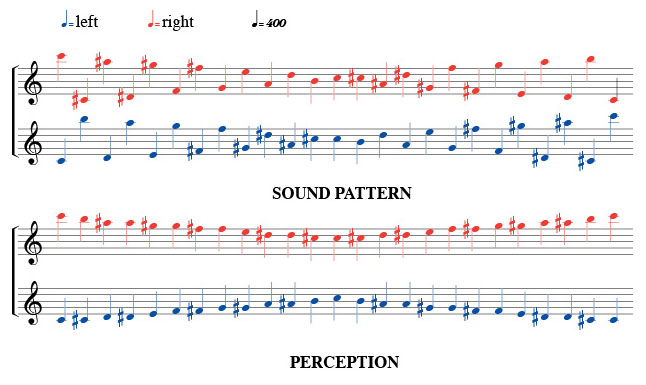| |
Chromatic Illusion
The Chromatic Illusion was discovered and first published by Deutsch in Audio Magazine, 19871. A chromatic scale that ranges over two octaves is repeatedly presented in both ascending and descending form, with the tones switching from ear to ear as in the Scale Illusion. When this pattern is played, many people hear a higher line that repeatedly moves down an octave and up again, together with a lower line that repeatedly moves up an octave and down again, with the two meeting in the middle. Yet when each channel is played separately, it is heard correctly as a series of tones that jump around in pitch. Figure 1 shows the pattern producing the Chromatic Illusion and how it is often perceived when played through stereo headphones. As with the Scale IIlusion, right-handers show a tendency to hear the higher tones on the right and the lower tones on the left, but left-handers as a group are much more variable in terms of what they hear.
 Play Deutsch's Chromatic Illusion (two-octave) Play Deutsch's Chromatic Illusion (two-octave)

Figure 1. The pattern that produces Deutsch’s Chromatic Illusion, and a way it is often perceived.
|
 Play Deutsch's Chromatic Illusion (one-octave) Play Deutsch's Chromatic Illusion (one-octave)

Figure 2. Same as Figure 1 but using one-octave chromatic scale.
|
It is interesting to listen to the Chromatic Illusion through stereo loudspeakers, with one to your left and the other to your right. Listen first with the channels playing simultaneously. Then play one channel separately, then the other channel separately, and then the two channels together again. When each channel is played separately, you hear tones that jump around in pitch. But when the two channels are played together, the brain reorganizes the tones so that two smooth melodies – a higher one and a lower one – are heard instead. This illusion is based on the same principle as I employed to generate the Scale Illusion.
References:
1. Deutsch, D. Illusions for Stereo Headphones. Audio Magazine, 1987, March, 36-48, [PDF Document]
2. Deutsch, D. (Ed.). Grouping mechanisms in music. Chapter 6 in The Psychology of Music, 3rd Edition, San Diego: Elsevier, 2013.
3. Deutsch, D. Some musical illusions are discovered. Chapter 2 in Musical Illusions and Phantom Words: How Music and Speech Unlock Mysteries of the Brain, Oxford University Press. 2019.
4. Deutsch, D. Musical Illusions and Phantom Words: How Music and Speech Unlock Mysteries of the Brain, Korean translation, 2023, Chapter 2, Eidos Publishing Group
5. Deutsch, D. Musical Illusions and Phantom Words: How Music and Speech Unlock Mysteries of the Brain, Chinese translation, Chapter 2, Guangxi Normal University Press, Group Co, Ltd., 2024.

| |